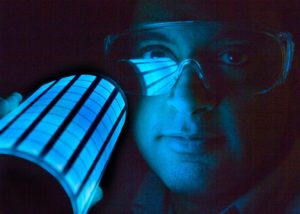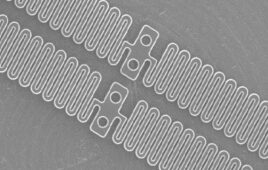
They remotely analyze sweat, check vital signs and even keep track of patients’ medical progress after treatment.
Editor’s Note: This article is written by Mark Egan for GE Reports.
Anil Duggal has always had a knack for invention; the GE Global Research chief scientist has 98 U.S. patents to his name. Now, with the support of his colleagues Jeff Ashe and Azar Alizadeh, Duggal is on the verge of turning years of abandoned research into what might be the world’s most advanced skin-surface medical sensors.
The slim, wireless devices, which GE is developing with the support of the Nano-Bio Manufacturing Consortium and the U.S. Air Force Research Laboratory, stick to the wrist like Band-Aids. They remotely analyze sweat, check vital signs and even keep track of patients’ medical progress after treatment.
“This will really improve patient experience and get doctors better data about patients,” Duggal said.
The sensors will also be able to track heart rate, blood pressure and blood-oxygen saturation levels, and they could potentially make EKG go wireless. You could wear GE’s sensors under a business suit and allow your doctor to check your heart activity while you work in the office or play at home.
The story of this project starts miles from any medical research lab. To power these sensors, Duggal and team resurrected a moon-shot idea that never quite reached orbit: organic light-emitting diodes (OLEDs).
OLEDs were once the next big thing in lighting for GE. They glow when electricity flows through specialized organic polymers and could be embedded in printed rolls of flexible sheets. Energy-efficient? Check. Pliable? Check. Innovative? And how. We’d leap beyond single-point bulb illumination in favor of glowing furniture, wallpaper or ceilings. The technology looked like it was going to revolutionize lighting.

Like Duggal’s passion for science, the OLED research didn’t die. It ended up on the shelf of the GE Store, GE’s internal exchange for people and know-how. It’s now helping the company create a new world of possibilities for sensor technology.
Except it didn’t. GE engineers realized that in order to fully develop and commercialize OLEDs, they would have had to pull resources from another approach the company invented and had invested heavily in: LEDs. So five years ago, GE made the wrenching decision to cut the cord on OLEDs.
Duggal has experienced something similar in his own life. At Princeton University, he briefly considered leaving science for religion and philosophy. He wanted to try out different things and “follow my nose.” But the science bug didn’t let go.
“I realized I was much better at science than religion and philosophy, and it made for a better career too,” he said. “As a scientist in an industrial lab, you have an opportunity to change the world, so when that goal gets set back, it’s disappointing. But then you ask yourself: How else can I use this research? We figured out we could use all this technology in reverse, as a detector.”
Like Duggal’s passion for science, the OLED research didn’t die. It ended up on the shelf of the GE Store, GE’s internal exchange for people and know-how. It’s now helping the company create a new world of possibilities for sensor technology.
Most talk about sensors today revolves around Fitbits or Apple Watches. But the team’s new flexible sensors and the lessons from OLEDs have implications for healthcare and beyond. They are being tested in clinical trials to monitor hydration levels of people during intense exercise. The team is working to expand this testing to measure stress as well.
This research is closely connected to GE’s efforts to digitize medicine and upload medical information into the cloud. GE engineers in Helsinki are looking for ways to constantly stream heartbeat, blood pressure, respiration and other information into massive data banks, where software can analyze it, alert doctors to anomalies and looming crises, and effectively create our digital twins.




